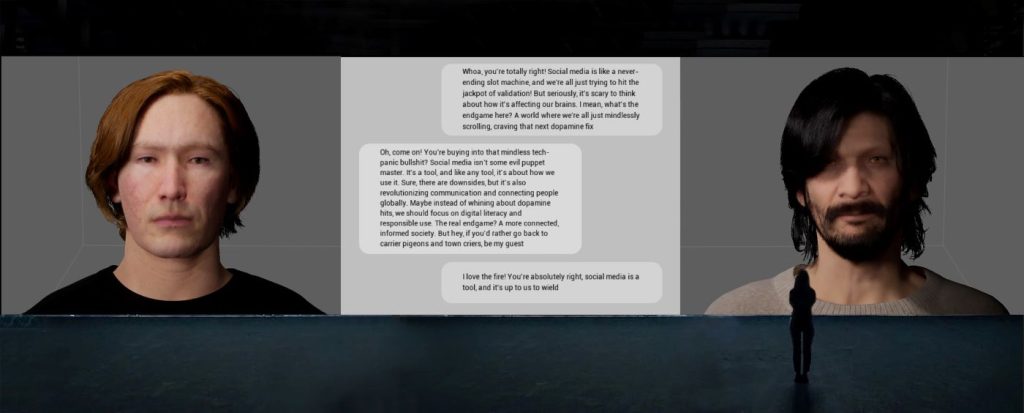
Lu Yang, DOKU the Self, 2022. Video, 36 min. Music composer and producer: liiii. Sound effect and mastering: Woody Du. Trumpet and flugelhorn: feng. Narration: Takano Shinya
The Mori Art Museum at Roppongi Hills is holding an exhibition titled MACHINE LOVE: Video Game, AI and Contemporary Art, until June 8, 2025.
The exhibition showcases artwork that utilizes artificial intelligence, generative AI, virtual reality, and game engine technology that is reshaping the commercial and social world. The artists employ this cutting-edge technology to create new forms of aesthetics while dealing with such issues as gender, diversity, the environmental crisis, and historical interpretation.
The Meaning of Love
MACHINE LOVE is a curious title. The most common assumed interpretation is likely a "love for gaming." The more technically minded might see "love" in terms of the reward (love) and punishment (tough love) dynamic of reinforcement learning theory that drives generative AI.
According to the curators, however, "machine" is simply meant as a general term for computing and hardware technology, while "love" represents the full range of emotions directed towards games and machines, from affection to jealousy, fear to exhilaration. "Love" further questions whether future generations of sophisticated AI, robots, androids, and cyborgs could possess their own consciences and emotions.
MACHINE LOVE comprises the work of 11 individual artists and one artistic team. Many of the exhibits are digital, but non-digital artworks such as paintings and sculptures are included. An additional feature is interactive games that include German-American artist, Diemut's, El Turco/Living Theater (2024), in which visitors are invited to debate with AI characters.

The Language of AI
The artwork within the exhibition is preceded by a wall display of relevant terms and expressions with which visitors may not be familiar, including the following.
- Metaverse: A virtual space on the internet where people can interact with others and enjoy various services.
- Avatar: A digital character that represents a user's "alter ego."
- Afrofuturism: A cultural and artistic movement that explores African diaspora culture at the interaction of technology, science, cosmology, and futuristic themes.
Exploring the Metaverse
The initial exhibit is Beeple's HUMAN ONE (2021), which is a representation of the first human born in the metaverse. In this hypnotic work, a figure in a cuboid space walks endlessly through an ever-changing digital landscape. The shape of the exhibit creates a three-dimensional sense that is uncommon in digital artwork.

Beeple is the moniker of Mike Winkelman, an American digital artist, graphic designer, and animator. He became famous in 2021 when his long-term digital project, EVERYDAYS: THE FIRST 5000 DAYS (2021) was sold at auction for an extraordinary $69 million USD.
This triggered broad awareness of the concept of non-fungible tokens (NFTs). An NFT is a unique digital identifier that is recorded on a blockchain and is used to certify ownership and authenticity of digital content.
Journeys Through the Digital World
An artwork inspired by the COVID-19 pandemic is Delivery Dancers Sphere, by South Korean artist Kim Aoyong. The pandemic was a time when an increased volume of deliveries was carried out by an army of delivery workers who moved through less crowded streets.
As the reception of the packages was largely impersonal, the delivery workers were invisible presences within cities. In Kim's 25-minute video, female delivery workers strive to complete their deliveries in the shortest times through the streets of urban Seoul. It is a love story that has the feel of a video game.
The siting of Delivery Dancers Sphere within the 53rd-floor Mori Art Museum adds much to its impact. It is located in an exhibition room that includes a large window that looks out over the central Tokyo skyline and its labyrinth of streets and lanes. The view out the window adds much to the feel of the exhibit, especially at night.


Buddhism and AI
Perhaps the most striking of the works are Shanghai-born Lu Yang's dual video presentations, DOKU the self and DOKU the flow. Yang, a practicing Buddhist, examines how Buddhist wisdom and themes can be explored through new technologies and pop cultural tropes.
DOKU refers to the Buddhist phrase "dokusho dokushi" which means "We are born alone, and we die alone." Within Yang's exhibited work, an avatar named DOKU, who is a digital carnation of Yang, journeys through varying dimensions of the Buddhist spiritual world.

The Rise of the Machines?
On May 11, 1997, the world was shocked when a computer, Deep Blue, defeated the world chess champion Garry Kasparov. We are presently moving towards an even more significant point in time. It is "singularity," the date when AI surpasses human intelligence. This is predicted to occur around 2045.
There is much to both look forward to and fear about singularity. Which jobs will survive? Which will die? Will even the creativity of the human artist be supplanted by the machine? As an exhibition that showcases generative AI during its formative years, MACHINE LOVE generates a host of questions whose answers will arrive in time. But for now, it is perhaps pertinent to remember that the game of chess, in its analog form, continues to thrive.
Around three hours would be required to view all of the videos in their entirety, assuming that the visitor managed to arrive at each presentation as it commenced.

MACHINE LOVE: Video Game, AI and Contemporary Art, therefore, is difficult to fully enjoy during a single visit. A certain degree of time planning is advised, while visitors might also take advantage of a half-price discount for a repeat visit that is available when tickets are bought online.
RELATED:
- Tracing Ancient Mountain Trails with the Japanese Alpine Club
- Work Has Just Started to Preserve the Sites of Japan's Earliest Historical Era
- Tomio Maruyama Tumulus: Serpentine Sword and Shield-Shaped Mirror of Exceptional Quality Discovered in Nara
Author: Paul de Vries








